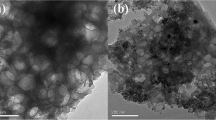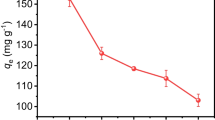Abstract
In this study, a carbonaceous aerogel with superior structural properties was synthesized from sodium alginate with a specific surface area and density of about 470 m2 g−1 and 0.05 g cm−3, respectively. In order to adsorb nitrate from water, the surface of the aerogel was modified by protonated cross-linked chitosan. To investigate the morphology, elemental composition, crystalline phases and surface functional groups of the adsorbent, various techniques such as field emission scanning electron microscopy, energy-dispersive X-ray spectroscopy, X-ray diffraction analysis, Fourier transform infrared spectroscopy were employed. To study the performance of this green adsorbent in nitrate removal process, the effect of nitrate initial concentration, adsorbent dosage, pH of solutions were investigated in batch mode. It was revealed that the Langmuir isotherm model could properly describe the experimental equilibrium data and the maximum adsorption capacity was evaluated to be about 18 mg g−1 at neutral pH and room temperature. Besides, the kinetic data perfectly followed the pseudo-second order model. Thermodynamic analysis showed that the adsorption reaction was spontaneous, exothermic with decreased randomness at the solid–liquid interface. The macroscopic size of the adsorbent allowed its facile separation from the solution.






Similar content being viewed by others
References
Afkhami A, Madrakian T, Karimi Z (2007) The effect of acid treatment of carbon cloth on the adsorption of nitrite and nitrate ions. J Hazard Mater 144(1):427–431
Bhatnagar A, Sillanpää M (2011) A review of emerging adsorbents for nitrate removal from water. Chem Eng J 168(2):493–504. https://doi.org/10.1016/j.cej.2011.01.103
Della Rocca C, Belgiorno V, Meriç S (2007) Overview of in situ applicable nitrate removal processes. Desalination 204(1):46–62
Loganathan P, Vigneswaran S, Kandasamy J (2013) Enhanced removal of nitrate from water using surface modification of adsorbents—a review. J Environ Manage 131:363–374
Rezaee A, Godini H, Dehestani S, Khavanin A (2008) Application of impregnated almond shell activated carbon by zinc and zinc sulfate for nitrate removal from water. J Environ Health Sci Eng 2:125–130
Batheja K, Sinha A, Seth G (2009) Studies on water treatment for removal of nitrate. Asian J Exp Sci 23(1):61–66
Mishra P, Patel R (2009) Use of agricultural waste for the removal of nitrate-nitrogen from aqueous medium. J Environ Manage 90(1):519–522
Karimi B, Rajaei MS, Ganadzadeh MJ, Mashayekhi M, Jahanbakhsh M (2013) Evaluation of nitrate removal from water by Fe/H2O2 and adsorption on activated carbon. Arak Med Univ J 15(10):67–76
World Health Organization (WHO) (2011) Guidelines for drinking-water quality. WHO Chron 38:104–108
United States of America Environmental Protection Agency (EPA) (2009) National primary drinking water standards. https://www.epa.gov/ground-water-and-drinking-water
Australian Drinking Water Guidlines 6 (ADWG) (2011) Version 3.2. National Health and Medical Research Council: Commonwealth of Australia, Canberra. https://www.clearwatervic.com.au/user-data/resource-files/Aust_drinking_water_guidelines.pdf
Masukume M, Eskandarpour A, Onyango MS, Ochieng A, Otieno F (2011) Treating high nitrate groundwater using surfactant modified zeolite in fixed bed column. Sep Sci Technol 46(7):1131–1137
Institute of Standards & Industrial Research of Iran (ISIRI) (1997) Physical and chemical quality of drinking water, Fifth edn, No. 1053, Tehran. http://www.environment-lab.ir/standards/water-drink-standard-1053.pdf
Wang Z, Jiang Y, Awasthi MK, Wang J, Yang X, Amjad A, Wang Q, Lahori AH, Zhang Z (2018) Nitrate removal by combined heterotrophic and autotrophic denitrification processes: impact of coexistent ions. Biores Technol 250:838–845. https://doi.org/10.1016/j.biortech.2017.12.009
Hojjat Ansari M, Basiri Parsa J (2016) Removal of nitrate from water by conducting polyaniline via electrically switching ion exchange method in a dual cell reactor: optimizing and modeling. Sep Purif Technol 169:158–170. https://doi.org/10.1016/j.seppur.2016.06.013
Epsztein R, Nir O, Lahav O, Green M (2015) Selective nitrate removal from groundwater using a hybrid nanofiltration—reverse osmosis filtration scheme. Chem Eng J 279:372–378. https://doi.org/10.1016/j.cej.2015.05.010
Djouadi Belkada F, Kitous O, Drouiche N, Aoudj S, Bouchelaghem O, Abdi N, Grib H, Mameri N (2018) Electrodialysis for fluoride and nitrate removal from synthesized photovoltaic industry wastewater. Sep Purif Technol 204:108–115. https://doi.org/10.1016/j.seppur.2018.04.068
Majlesi M, Mohseny SM, Sardar M, Golmohammadi S, Sheikhmohammadi A (2016) Improvement of aqueous nitrate removal by using continuous electrocoagulation/electroflotation unit with vertical monopolar electrodes. Sustain Environ Res 26(6):287–290. https://doi.org/10.1016/j.serj.2016.09.002
Ghaemi N, Daraei P, Akhlaghi FS (2018) Polyethersulfone nanofiltration membrane embedded by chitosan nanoparticles: fabrication, characterization and performance in nitrate removal from water. Carbohyd Polym 191:142–151. https://doi.org/10.1016/j.carbpol.2018.03.024
Tabrizi N, Yavari M (2015) Methylene blue removal by carbon nanotube-based aerogels. Chem Eng Res Des 94:516–523
Öztürk N, Bektaş TE (2004) Nitrate removal from aqueous solution by adsorption onto various materials. J Hazard Mater 112(1):155–162. https://doi.org/10.1016/j.jhazmat.2004.05.001
Tyagi S, Rawtani D, Khatri N, Tharmavaram M (2018) Strategies for nitrate removal from aqueous environment using nanotechnology: a review. J Water Process Eng 21:84–95. https://doi.org/10.1016/j.jwpe.2017.12.005
Khan MA, Ahn YT, Kumar M, Lee W, Min B, Kim G, Cho DW, Park WB, Jeon BH (2011) Adsorption studies for the removal of nitrate using modified lignite granular activated carbon. Sep Sci Technol 46(16):2575–2584. https://doi.org/10.1080/01496395.2011.601782
Marsh H, Reinoso FR (2006) Activated carbon, 1st edn. Elsevier, Amsterdam, ISBN: 9780080455969
Aygün A et al (2003) Production of granular activated carbon from fruit stones and nutshells and evaluation of their physical, chemical and adsorption properties. Micropor Mesopor Mater 66(2):189–195
Khani A, Mirzaei M (2008) Comparative study of nitrate removal from aqueous solution using powder activated carbon and carbon nanotubes. In: 2nd Inter-national IUPAC conference on green chemistry, Russia, pp 14–19
Kaneko K, Camara S, Ozeki S, Souma M (1991) Dynamic NO3 − adsorption characteristics of iron oxide-dispersed activated carbon fibers. Carbon 29:1287–1289
Meena AK et al (2005) Removal of heavy metal ions from aqueous solutions using carbon aerogel as an adsorbent. J Hazard Mater 122(1):161–170
Bhatnagar A, Ji M, Choi YH, Jung W, Lee SH, Kim SJ, Lee G, Suk H, Kim SH, Min B, Kim SH, Jeon BH, Kang JW (2008) Removal of nitrate from water by adsorption onto zinc chloride treated activated carbon. Sep Sci Technol 43(4):886–907. https://doi.org/10.1080/01496390701787461
Bombuwala Dewage N et al (2019) Fast aniline and nitrobenzene remediation from water on magnetized and nonmagnetized douglas fir biochar. Chemosphere 225:943–953
Mohan D et al (2007) Sorption of arsenic, cadmium, and lead by chars produced from fast pyrolysis of wood and bark during bio-oil production. J Colloid Interface Sci 310(1):57–73
White RJ, Budarin V, Luque R, Clark JH, Macquarrie DJ (2009) Tuneable porous carbonaceous materials from renewable resources. Chem Soc Rev 38(12):3401–3418
Daemi H, Barikani M, Barmar M (2013) Variations in calcium and alginate ions concentration in relation to the properties of calcium alginate nanoparticles. Sci Technol 26(1):25–32
Jaafari K, Elmaleh S, Coma J, Benkhouja K (2001) Equilibrium and kinetics of nitrate removal by protonated cross-linked chitosan. WaterSA 27(1):9–14
Liu Y, Nguyen LD, Truong-Huu T, Liu Y, Romero T, Janowska I, Begin D, Pham-Huu C (2012) Macroscopic shaping of carbon nanotubes with high specific surface area and full accessibility. Mater Lett 79:128–131
Golie WM, Upadhyayula S (2016) Continuous fixed-bed column study for the removal of nitrate from water using chitosan/alumina composite. J Water Process Eng 12:58–65
Wang L, Li X, Ma J, Wu Q, Duan X (2014) Non-activated, N, S-co-doped biochar derived from banana with superior capacitive properties. Sustain Energy 2(2):39–43
Bombuwala Dewage N et al (2018) Lead (Pb2+) sorptive removal using chitosan-modified biochar: batch and fixed-bed studies. RSC Adv 8(45):25368–25377
Rohindra DR, Nand AV, Khurma JR (2004) Swelling properties of chitosan hydrogels. S Pac J Natl Sci 22(1):32–35
de Pinho Neves A L, Milioli CC, Müller L, Riella HG, Kuhnen NC, Stulzer HK (2014) Factorial design as tool in chitosan nanoparticles development by ionic gelation technique. Colloids Surf A 445:34–39
Mi X, Huang G, Xie W, Wang W, Liu Y, Gao J (2012) Preparation of graphene oxide aerogel and its adsorption for Cu2+ ions. Carbon 50(13):4856–4864. https://doi.org/10.1016/j.carbon.2012.06.013
Zamani S, Tabrizi NS (2015) Removal of methylene blue from water by graphene oxide aerogel: thermodynamic, kinetic, and equilibrium modeling. Res Chem Intermed 41(10):7945–7963
Zhan Y, Lin J, Zhu Z (2011) Removal of nitrate from aqueous solution using cetylpyridinium bromide (CPB) modified zeolite as adsorbent. J Hazard Mater 186(2–3):1972–1978. https://doi.org/10.1016/j.jhazmat.2010.12.090
Namasivayam C, Sangeetha D (2005) Removal and recovery of nitrate from water by ZnCl2 activated carbon from coconut coir pith, an agricultural solid waste. Indian J Chem Technol 12(5):513
Mizuta K, Matsumoto T, Hatate Y, Nishihara K, Nakanishi T (2004) Removal of nitrate-nitrogen from drinking water using bamboo powder charcoal. Biores Technol 95(3):255–257. https://doi.org/10.1016/j.biortech.2004.02.015
Nunell G, Fernandez M, Bonelli P, Cukierman A (2015) Nitrate uptake improvement by modified activated carbons developed from two species of pine cones. J Colloid Interface Sci 440:102–108
Bombuwala Dewage N et al (2018) Fast nitrate and fluoride adsorption and magnetic separation from water on α-Fe2O3 and Fe3O4 dispersed on douglas fir biochar. Bioresour Technol 263:258–265
Ganesan P, Kamaraj R, Vasudevan S (2013) Application of isotherm, kinetic and thermodynamic models for the adsorption of nitrate ions on graphene from aqueous solution. J Taiwan Inst Chem Eng 44(5):808–814
Zhao G, Ren X, Gao X, Tan X, Li J, Chen C, Huang Y, Wang X (2011) Removal of Pb(II) ions from aqueous solutions on few-layered graphene oxide nanosheets. Dalton Trans 40(41):10945–10952. https://doi.org/10.1039/c1dt11005e
Parker HL, Budarin VL, Clark JH, Hunt AJ (2013) Use of starbon for the adsorption and desorption of phenols. ACS Sustain Chem Eng 1:1311–1318
Tan I, Ahmad AL, Hameed B (2008) Adsorption of basic dye on high-surface-area activated carbon prepared from coconut husk: equilibrium, kinetic and thermodynamic studies. J Hazard Mater 154(1):337–346
Acknowledgement
The present study was jointly funded by Materials and Energy Research Center (MERC, No. 521394001) and Iran National Science Foundation (INSF, No. 92029037).
Author information
Authors and Affiliations
Corresponding author
Additional information
Publisher's Note
Springer Nature remains neutral with regard to jurisdictional claims in published maps and institutional affiliations.
Rights and permissions
About this article
Cite this article
Kheirabadi, N.R., Tabrizi, N.S. & Sangpour, P. Removal of Nitrate from Water by Alginate-Derived Carbon Aerogel Modified by Protonated Cross-Linked Chitosan. J Polym Environ 27, 1642–1652 (2019). https://doi.org/10.1007/s10924-019-01458-3
Published:
Issue Date:
DOI: https://doi.org/10.1007/s10924-019-01458-3




